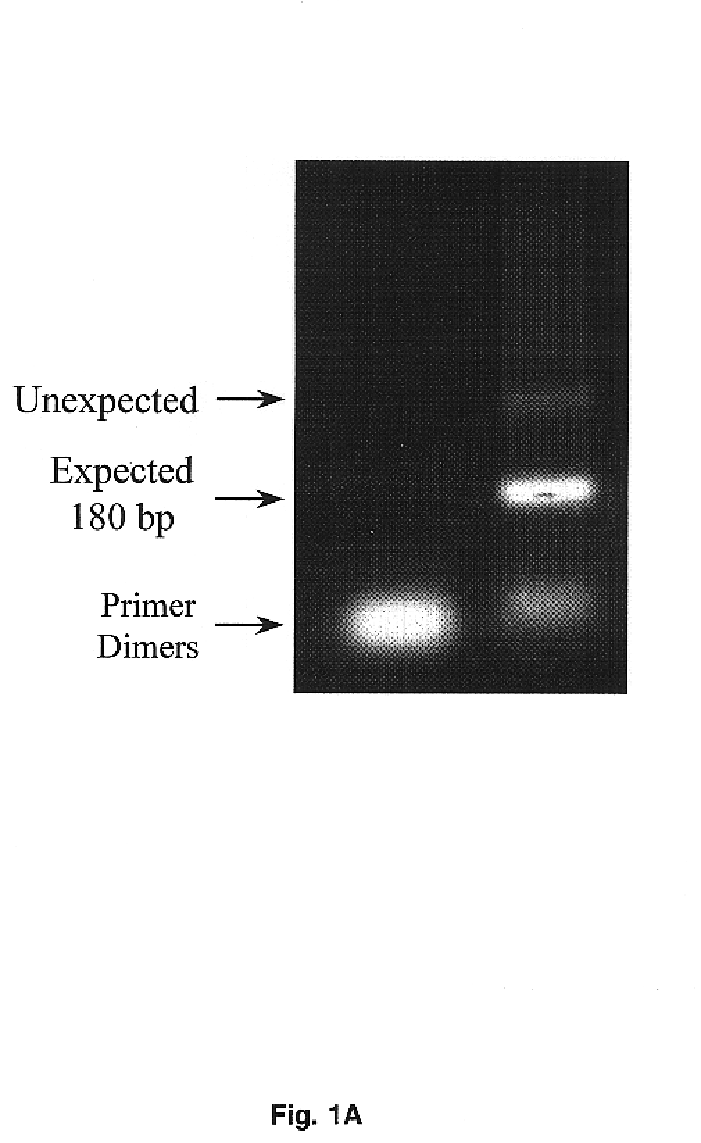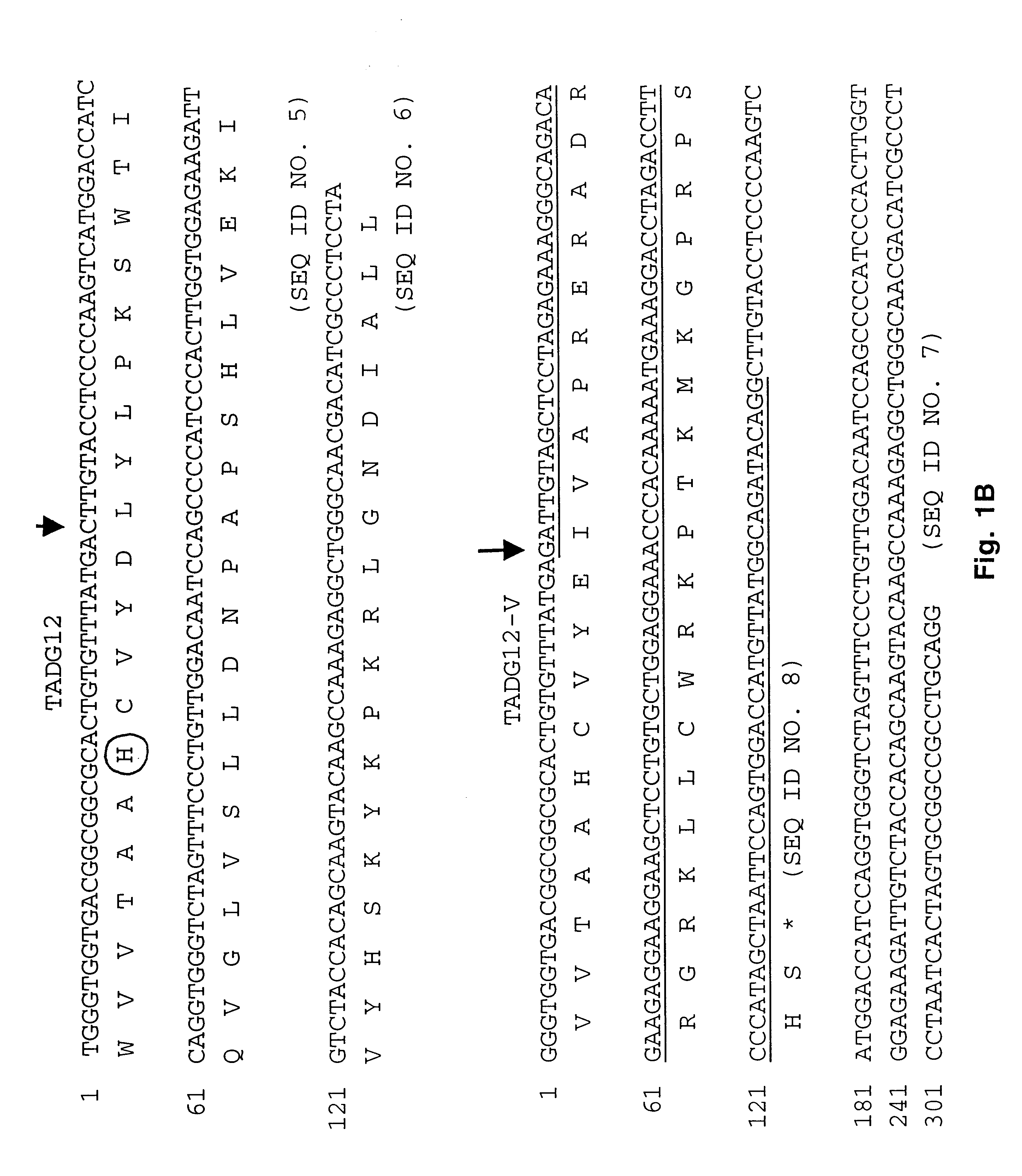Transmembrane serine protease overexpressed in ovarian carcinoma and uses thereof
a technology of ovarian cancer and transmembrane serine protease, which is applied in the field of cellular biology and diagnosis of neoplastic disease, can solve the problems of inability to prove an ideal marker for early diagnosis, lack of tumor markers useful as indicators of early disease, and inability to express a tadg-12 protein, etc., to achieve the effect of inhibiting the expression of tadg-12 protein
- Summary
- Abstract
- Description
- Claims
- Application Information
AI Technical Summary
Benefits of technology
Problems solved by technology
Method used
Image
Examples
example 1
Tissue Collection and Storage
[0094]Upon patient hysterectomy, bilateral salpingo-oophorectomy, or surgical removal of neoplastic tissue, the specimen is retrieved and placed on ice. The specimen was then taken to the resident pathologist for isolation and identification of specific tissue samples. Finally, the sample was frozen in liquid nitrogen, logged into the laboratory record and stored at −80° C. Additional specimens were frequently obtained from the Cooperative Human Tissue Network (CHTN). These samples were prepared by the CHTN and shipped on dry ice. Upon arrival, these specimens were logged into the laboratory record and stored at −80° C.
example 2
mRNA Extraction and cDNA Synthesis
[0095]Sixty-nine ovarian tumors (4 benign tumors, 10 low malignant potential tumors and 55 carcinomas) and 10 normal ovaries were obtained from surgical specimens and frozen in liquid nitrogen. The human ovarian carcinoma cell lines SW 626 and Caov 3, the human breast carcinoma cell lines MDA-MB-231 and MDA-MB-435S were purchased from the American Type Culture Collection (Rockville, Md.). Cells were cultured to sub-confluency in Dulbecco's modified Eagle's medium, supplemented with 10% (v / v) fetal bovine serum and antibiotics.
[0096]Extraction of mRNA and cDNA synthesis were carried out by the methods described previously [14-16]. mRNA was isolated by using a RiboSep mRNA isolation kit (Becton Dickinson Labware). In this procedure, poly A+ mRNA was isolated directly from the tissue lysate using the affinity chromatography media oligo(dT) cellulose. cDNA was synthesized with 5.0 μg of mRNA by random hexamer priming using 1st strand cDNA synthesis kit ...
example 3
PCR with Redundant Primers and Cloning of TADG-12 cDNA
[0097]Redundant primers, forward 5′-TGGGTIGTIACIGCIGCICA (CT)TG -3′ (SEQ ID No. 26) and reverse 5′-A(AG)IA(AG)IGCIATITCI TTICC-3′ (SEQ ID No. 27), for the consensus sequences of amino acids surrounding the catalytic triad for serine proteases were used to compare the PCR products from normal and carcinoma cDNAs. The appropriate bands were ligated into Promega T-vector plasmid and the ligation product was used to transform JM109 cells (Promega) grown on selection media. After selection of individual colonies, they were cultured and plasmid DNA was isolated by means of the Wizard miniprep DNA purification system (Promega). Nucleotide sequencing was performed using PRISM Ready Reaction Dye Deoxy terminator cycle sequence kit (Applied Biosystems). Applied Biosystems Model 373A DNA sequencing system was used for direct cDNA sequence determination.
[0098]The original TADG-12 subclone was randomly labeled and used as a probe to screen an...
PUM
| Property | Measurement | Unit |
|---|---|---|
| Fraction | aaaaa | aaaaa |
| Fraction | aaaaa | aaaaa |
| Fraction | aaaaa | aaaaa |
Abstract
Description
Claims
Application Information
 Login to View More
Login to View More - R&D
- Intellectual Property
- Life Sciences
- Materials
- Tech Scout
- Unparalleled Data Quality
- Higher Quality Content
- 60% Fewer Hallucinations
Browse by: Latest US Patents, China's latest patents, Technical Efficacy Thesaurus, Application Domain, Technology Topic, Popular Technical Reports.
© 2025 PatSnap. All rights reserved.Legal|Privacy policy|Modern Slavery Act Transparency Statement|Sitemap|About US| Contact US: help@patsnap.com



